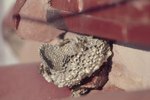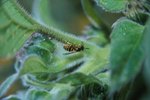
While wasps and hornet species exhibit subtle differences in nesting habits, most have similar life cycles -- workers and males die in the fall or winter, and only the mated queens survive. New queens hibernate over the winter and start new nests each spring. Because they do not come back to their old nests, you can remove a wasp or hornet nest and keep it without worry that wasps will return to reclaim it.
Variation in Wasp Nests
Hornets, wasps and yellow jackets produce nests that are slightly different from one another. Most yellow jackets construct their papery nests underground, in rodent burrows or other holes; however, some German yellow jackets (Vespula germanica) occasionally nest inside the walls of buildings. Aerial yellow jackets (Dolichovespula spp.) and European hornets (Vespa spp.) construct similar nests, usually located on a tree branch or under a porch, roof or eave. Paper wasps (Polistes spp.) make smaller, umbrella shaped nests that generally contain fewer cells than yellow jacket or hornet nests do. Paper wasps usually suspend their nests from horizontal surfaces, but introduced European wasps sometimes position their nests on vertical structures as well.
Long Live the Queen
In the vast majority of cases, mated queens are the only wasps and hornets to survive the winter. They do so by hibernating under bark, in a rock crevice or in a burrow. When spring arrives, they wake up and start constructing a new nest -- queens never go back to their old ones. After creating a few initial chambers and filling them with eggs, the queen will be on her way to amassing a labor force. The nest grows over the spring and summer as the colony increases in size. By late fall, the queen has produced a few new, unmated queens and males, who will leave the nest and mate. While the newly mated queens find somewhere to hibernate, the males, workers and old queen will die as winter sets in.
Don’t Stop Bee-Leaving
Honeybees (Apis spp.) are the only bees or wasps to construct nests that last for longer than one year. However, some wasps -- particularly German yellow jackets -- survive the winter and the nests become perennial rather than annual. This phenomenon occasionally occurs in western yellow jackets (Vespula pensylvanica) as well, particularly those that have invaded Hawaii. This phenomenon is most common in areas with mild or warm winters, or among those nesting in warm places, such as voids inside heated buildings. While such nests may utilize different queens over time, the colony uses the same nest until they die. Not even perennial species will colonize old nests.
Decoration and Education
Many people like to collect old wasp or hornet nests for decorative or educational purposes. Generally, the colonies have died by the cool days in November, at which time, the University of Idaho’s extension service recommends. you can collect them. It is also possible -- and slightly safer -- to wait until after the second night of freezing temperatures to collect a nest, but as nests are fragile, the wind and rain may damage them by this time. In either case, place the nest in a sealed garbage bag and place it in the freezer for at least 48 hours to kill any insects still inside the nest. Though the papery nest material will deteriorate over time, with good care, it should stay relatively intact for years.
References
- University of Idaho Extension: Homeowners Guide to Yellowjackets, Bald-Faced Hornets and Paper Wasps
- University of Tennessee Extension: Yellowjacket Wasps in Tennessee
- Colorado State University: Nuisance Wasps and Bees
- University of Minnesota Extension: Bee Lab: Honey Bee or Yellowjacket Wasp?
- Proceedings of the National Academy of Sciences: Life History Plasticity Magnifies the Ecological Effects of a Social Wasp Invasion
Photo Credits
-
Jupiterimages/Photos.com/Getty Images




